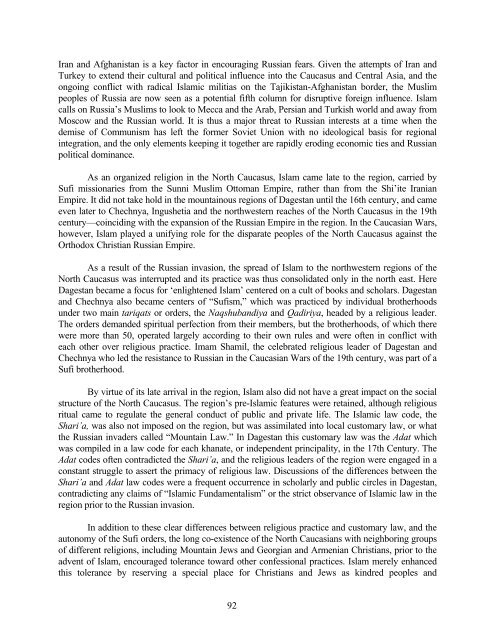RUSSIA'S TINDERBOX - Belfer Center for Science and International ...
RUSSIA'S TINDERBOX - Belfer Center for Science and International ...
RUSSIA'S TINDERBOX - Belfer Center for Science and International ...
Create successful ePaper yourself
Turn your PDF publications into a flip-book with our unique Google optimized e-Paper software.
Iran <strong>and</strong> Afghanistan is a key factor in encouraging Russian fears. Given the attempts of Iran <strong>and</strong><br />
Turkey to extend their cultural <strong>and</strong> political influence into the Caucasus <strong>and</strong> Central Asia, <strong>and</strong> the<br />
ongoing conflict with radical Islamic militias on the Tajikistan-Afghanistan border, the Muslim<br />
peoples of Russia are now seen as a potential fifth column <strong>for</strong> disruptive <strong>for</strong>eign influence. Islam<br />
calls on Russia’s Muslims to look to Mecca <strong>and</strong> the Arab, Persian <strong>and</strong> Turkish world <strong>and</strong> away from<br />
Moscow <strong>and</strong> the Russian world. It is thus a major threat to Russian interests at a time when the<br />
demise of Communism has left the <strong>for</strong>mer Soviet Union with no ideological basis <strong>for</strong> regional<br />
integration, <strong>and</strong> the only elements keeping it together are rapidly eroding economic ties <strong>and</strong> Russian<br />
political dominance.<br />
As an organized religion in the North Caucasus, Islam came late to the region, carried by<br />
Sufi missionaries from the Sunni Muslim Ottoman Empire, rather than from the Shi’ite Iranian<br />
Empire. It did not take hold in the mountainous regions of Dagestan until the 16th century, <strong>and</strong> came<br />
even later to Chechnya, Ingushetia <strong>and</strong> the northwestern reaches of the North Caucasus in the 19th<br />
century—coinciding with the expansion of the Russian Empire in the region. In the Caucasian Wars,<br />
however, Islam played a unifying role <strong>for</strong> the disparate peoples of the North Caucasus against the<br />
Orthodox Christian Russian Empire.<br />
As a result of the Russian invasion, the spread of Islam to the northwestern regions of the<br />
North Caucasus was interrupted <strong>and</strong> its practice was thus consolidated only in the north east. Here<br />
Dagestan became a focus <strong>for</strong> ‘enlightened Islam’ centered on a cult of books <strong>and</strong> scholars. Dagestan<br />
<strong>and</strong> Chechnya also became centers of “Sufism,” which was practiced by individual brotherhoods<br />
under two main tariqats or orders, the Naqshub<strong>and</strong>iya <strong>and</strong> Qadiriya, headed by a religious leader.<br />
The orders dem<strong>and</strong>ed spiritual perfection from their members, but the brotherhoods, of which there<br />
were more than 50, operated largely according to their own rules <strong>and</strong> were often in conflict with<br />
each other over religious practice. Imam Shamil, the celebrated religious leader of Dagestan <strong>and</strong><br />
Chechnya who led the resistance to Russian in the Caucasian Wars of the 19th century, was part of a<br />
Sufi brotherhood.<br />
By virtue of its late arrival in the region, Islam also did not have a great impact on the social<br />
structure of the North Caucasus. The region’s pre-Islamic features were retained, although religious<br />
ritual came to regulate the general conduct of public <strong>and</strong> private life. The Islamic law code, the<br />
Shari’a, was also not imposed on the region, but was assimilated into local customary law, or what<br />
the Russian invaders called “Mountain Law.” In Dagestan this customary law was the Adat which<br />
was compiled in a law code <strong>for</strong> each khanate, or independent principality, in the 17th Century. The<br />
Adat codes often contradicted the Shari’a, <strong>and</strong> the religious leaders of the region were engaged in a<br />
constant struggle to assert the primacy of religious law. Discussions of the differences between the<br />
Shari’a <strong>and</strong> Adat law codes were a frequent occurrence in scholarly <strong>and</strong> public circles in Dagestan,<br />
contradicting any claims of “Islamic Fundamentalism” or the strict observance of Islamic law in the<br />
region prior to the Russian invasion.<br />
In addition to these clear differences between religious practice <strong>and</strong> customary law, <strong>and</strong> the<br />
autonomy of the Sufi orders, the long co-existence of the North Caucasians with neighboring groups<br />
of different religions, including Mountain Jews <strong>and</strong> Georgian <strong>and</strong> Armenian Christians, prior to the<br />
advent of Islam, encouraged tolerance toward other confessional practices. Islam merely enhanced<br />
this tolerance by reserving a special place <strong>for</strong> Christians <strong>and</strong> Jews as kindred peoples <strong>and</strong><br />
92
















